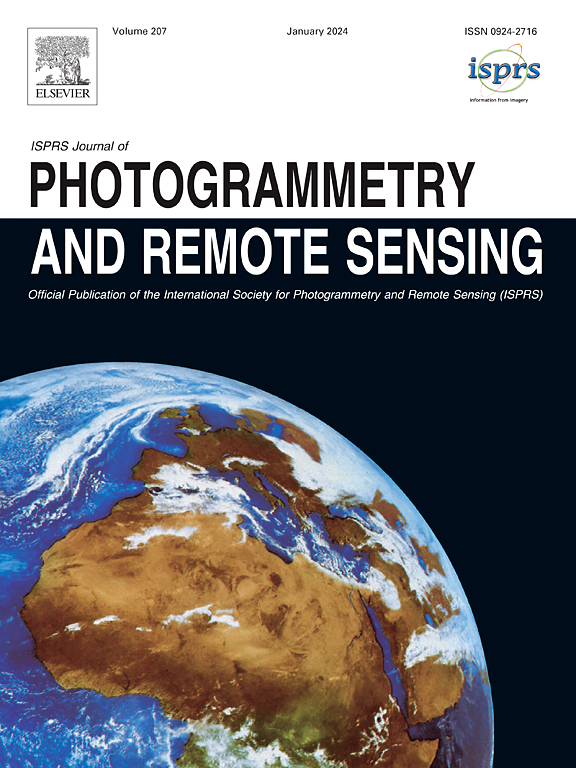Cloud removal with optical and SAR imagery via multimodal similarity attention
IF 10.6
1区 地球科学
Q1 GEOGRAPHY, PHYSICAL
ISPRS Journal of Photogrammetry and Remote Sensing
Pub Date : 2025-05-16
DOI:10.1016/j.isprsjprs.2025.05.004
引用次数: 0
Abstract
Optical remote sensing images are crucial data sources for various applications, including agricultural monitoring, land cover classification, and urban planning. However, cloud cover often hinders their effectiveness, which poses a significant challenge to downstream tasks. To address this issue, we introduce the Similarity-based Multimodal De-Clouding Network (SMDCNet), an innovative framework that enhances the quality of optical remote sensing images by utilizing multimodal similarity attention to integrate complementary information from synthetic aperture radar (SAR) imagery. First, we introduce a similarity feature attention (SFA) module that explores the similarity between optical and SAR features, aligning these cross-domain features to guide the optical encoder’s focus on cloud-free regions for more accurate feature alignment. Building on this, we propose a differential feature extraction (DFE) module that selectively uses SAR features to compensate for cloud-covered regions in the optical images. To mitigate the blurriness in the de-clouded images, we incorporate differential characteristics injection (DCI) and multi-scale feature fusion (MSFF) modules, which collaboratively enhance the reconstruction of detailed information. Our experiments on the SEN12MS-CR dataset demonstrate that SMDCNet effectively restores high-quality cloud-free images, achieving a PSNR of 30.2759 dB, outperforming state-of-the-art cloud removal techniques.
基于多模态相似关注的光学和SAR图像去云
光学遥感图像是农业监测、土地覆盖分类和城市规划等各种应用的重要数据源。然而,云层经常阻碍它们的有效性,这对下游任务构成了重大挑战。为了解决这一问题,我们引入了基于相似性的多模态去云网络(SMDCNet),这是一个创新的框架,通过利用多模态相似性关注来整合合成孔径雷达(SAR)图像的互补信息,从而提高光学遥感图像的质量。首先,我们引入了相似特征关注(SFA)模块,该模块探索光学和SAR特征之间的相似性,对齐这些跨域特征,以指导光学编码器将重点放在无云区域,以实现更准确的特征对齐。在此基础上,我们提出了一种差分特征提取(DFE)模块,该模块选择性地使用SAR特征来补偿光学图像中的云覆盖区域。为了减轻去云图像的模糊性,我们将差分特征注入(DCI)和多尺度特征融合(MSFF)模块结合起来,协同增强了细节信息的重建。我们在SEN12MS-CR数据集上的实验表明,SMDCNet有效地恢复了高质量的无云图像,PSNR达到30.2759 dB,优于最先进的云去除技术。
本文章由计算机程序翻译,如有差异,请以英文原文为准。
求助全文
约1分钟内获得全文
求助全文
来源期刊

ISPRS Journal of Photogrammetry and Remote Sensing
工程技术-成像科学与照相技术
CiteScore
21.00
自引率
6.30%
发文量
273
审稿时长
40 days
期刊介绍:
The ISPRS Journal of Photogrammetry and Remote Sensing (P&RS) serves as the official journal of the International Society for Photogrammetry and Remote Sensing (ISPRS). It acts as a platform for scientists and professionals worldwide who are involved in various disciplines that utilize photogrammetry, remote sensing, spatial information systems, computer vision, and related fields. The journal aims to facilitate communication and dissemination of advancements in these disciplines, while also acting as a comprehensive source of reference and archive.
P&RS endeavors to publish high-quality, peer-reviewed research papers that are preferably original and have not been published before. These papers can cover scientific/research, technological development, or application/practical aspects. Additionally, the journal welcomes papers that are based on presentations from ISPRS meetings, as long as they are considered significant contributions to the aforementioned fields.
In particular, P&RS encourages the submission of papers that are of broad scientific interest, showcase innovative applications (especially in emerging fields), have an interdisciplinary focus, discuss topics that have received limited attention in P&RS or related journals, or explore new directions in scientific or professional realms. It is preferred that theoretical papers include practical applications, while papers focusing on systems and applications should include a theoretical background.
 求助内容:
求助内容: 应助结果提醒方式:
应助结果提醒方式:


